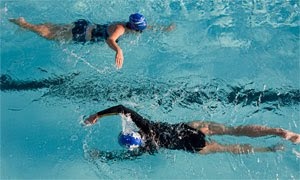Last week on Feel For The Water we posed the question, should you focus on reducing drag or increasing propulsion in your individual stroke? The answer is important as it will give a real focus to your technique sets. If you're stuck on a performance plateau this can really help you understand how to move forward.
Without a coach to watch you swim it can be hard to figure out which you should work on. Here are some simple tips to help you understand whether excess drag or a lack of propulsion is holding you back:
1) Do you find it considerably easier to swim with a pull buoy between your legs? If you do, this is a good indication that either your body position is quite low when you swim normally or your kicking technique is poor. These factors will be creating a lot of drag and extra effort when you swim.
2) If you find it slower or harder to swim with a pull buoy, this suggests your arm propulsion is a little lacking and you're relying on your kick for propulsion. A focus on developing your catch and pull technique will pay dividends. At first you may feel an increase in effort as you develop your arm propulsion, however you can offset that by reducing your kick strength. Overall you'll be a faster more efficient swimmer because arm propulsion is many times more efficient than kick propulsion.
3) Have you developed your swimming by stretching out and taking as few strokes as possible? This process of lengthening will normally reduce your drag by getting you into a long and straight position in the water. That's great but most swimmers doing this will introduce glide at the same time, which isn't so good. Glide is a bad thing for your propulsion in several ways but one of the most common problems is that in over-reaching you tend to drop your wrist and show your palm forwards. This causes your elbow to drop too, totally ruining your catch on the water:
If you have developed an over-gliding style you almost certainly need to work on your propulsion. When you're swimming, try not to over-reach at the front of the stroke. It's better to have slightly less reach and a vastly improved catch. It'll make things more efficient and more rhythmic too. The first step is to develop a cocked wrist position at the front of your stroke just like Mr Smooth:

4) Do you feel very one-paced when you swim? If a coach asked you to swim easy, moderate or hard do you think you'd just end up swimming the same speed? This is a classic symptom of a lack of arm propulsion in your swimming. If this is you, it's very likely you're pushing down on the water at the front of your stroke - all this does is lift you up at the front end and sink your legs. So as you work harder you also create more drag - and end up going about the same speed! The solution is to work on initiating your stroke by tipping your wrist and bending your elbow at the front of your stroke. This will allow you to press the water back towards the wall behind you rather than pushing it down. Think of this action as a gentle caress - it doesn't need to be hard but it does need to be in the right direction. Find out more here:
www.swimsmooth.com/catch
Swim Smooth!

















